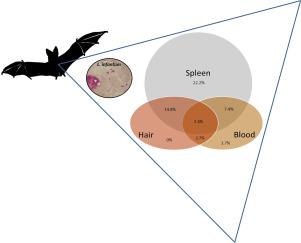Research in Veterinary Science ( IF 2.2 ) Pub Date : 2020-06-19 , DOI: 10.1016/j.rvsc.2020.06.019 Iris Azami-Conesa 1 , Rafael A Martínez-Díaz 2 , Fernando González 3 , María Teresa Gómez-Muñoz 1

|
Leishmania infantum is a protozoan causing leishmaniasis in humans and in dogs, among other animals, which is an endemic disease in the Mediterranean basin. In recent years, the role of wildlife as a possible reservoir of the disease was analyzed and several species of carnivores were reported to have the highest infection rates, with foxes and wolves being the more widely studied species; the role of rabbits and hares as reservoirs of leishmaniasis has also been described. In addition, several studies highlighted the role of bats as suitable hosts for Leishmania species (L. braziliensis, L. major, L. mexicana, and L. tropica) in South and Central America and Africa, but no Leishmania spp. infection in Chiroptera has been reported in Europe. In this study, samples from spleen, hair, and blood were analyzed to detect L. infantum DNA in bats from the Community of Madrid (Spain). Infection by L. infantum was detected in 59.2% of the bats studied (n = 16/27), with the spleen being selected as the site for detection, yielding 14/16 positive results (87.5% sensitivity), followed by hair (n = 7/16) and blood (n = 6/16). In two animals, samples from all three anatomical sites tested positive (7.4% of the total animals), while in four animals the spleen and hair samples tested positive (14.8%), in one animal the blood and hair samples tested positive (3.7%), and in another animal the blood sample only tested positive (3.7%). This is the first report of L. infantum detection in the common urban bat (Pipistrellus pipistrellus) in Europe.
中文翻译:

在欧洲常见的城市蝙蝠Pipistrellus pipistrellus中首次发现婴儿利什曼原虫。
婴儿利什曼原虫是一种原生动物,可引起人和狗等动物的利什曼病,这是地中海盆地的一种地方病。近年来,分析了野生生物作为该病可能的病原体的作用,据报道有几种食肉动物感染率最高,狐狸和狼是研究最广泛的物种。还描述了兔子和野兔作为利什曼病贮藏库的作用。此外,一些研究强调蝙蝠为适合主机的作用利什曼原虫种(L. braziliensis,硕大利什曼原虫,L.墨西哥和大号。tropica在中南美洲和非洲),但没有利什曼原虫spp。欧洲已经报道了翼手目感染。在这项研究中,进行了分析从脾,毛发和血液样品以检测大号。来自马德里自治区(西班牙)的蝙蝠中的婴儿DNA 。L感染。在所研究的蝙蝠中,有59.2%的婴儿被检出婴儿(n = 16/27),选择了脾脏作为检测部位,产生了14/16的阳性结果(灵敏度为87.5%),其次是头发(n = 7/16) )和血(n = 6/16)。在两只动物中,来自所有三个解剖部位的样品测试均为阳性(占总动物的7.4%),而在四只动物中,脾脏和头发样品测试为阳性(14.8%),在一只动物中血液和头发样品的测试为阳性(3.7%) ),而在另一只动物中,血液样本的检测结果仅为阳性(3.7%)。这是L的第一个报告。在欧洲常见的城市蝙蝠(Pipistrellus pipistrellus)中检测婴儿。











































 京公网安备 11010802027423号
京公网安备 11010802027423号